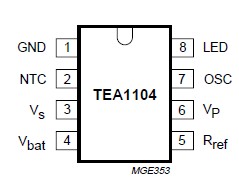TEA1104: Features: · Accurate detection of fully charged batteries by currentless peak voltage sensing· Switch-over from fast to safe trickle charge current at battery full detection· Fast charge termination...
floor Price/Ceiling Price
- Part Number:
- TEA1104
- Supply Ability:
- 5000
Price Break
- Qty
- 1~5000
- Unit Price
- Negotiable
- Processing time
- 15 Days
SeekIC Buyer Protection PLUS - newly updated for 2013!
- Escrow Protection.
- Guaranteed refunds.
- Secure payments.
- Learn more >>
Month Sales
268 Transactions
Payment Methods
All payment methods are secure and covered by SeekIC Buyer Protection PLUS.

 TEA1104 Data Sheet
TEA1104 Data Sheet








